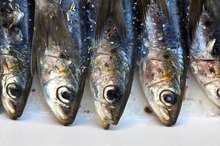What does fact checked mean?
At Healthfully, we strive to deliver objective content that is accurate and up-to-date. Our team periodically reviews articles in order to ensure content quality. The sources cited below consist of evidence from peer-reviewed journals, prominent medical organizations, academic associations, and government data.
- Centers for Disease Control and Prevention: Surveillance for Foodborne Disease Outbreaks United States, 2013: Annual Report
- Emerging Infectious Diseases: Foodborne Illness Acquired in the United States—Major Pathogens
- Emerging Infectious Diseases: Foodborne Illness Acquired in the United States—Major Pathogens
- Centers for Disease Control and Prevention: Hepatitis A Questions and Answers for the Public
- Centers for Disease Control and Prevention: Anisakiasis FAQs
- Journal of Food Protection: Prevalence and Antimicrobial Susceptibility of Major Foodborne Pathogens in Imported Seafood.
- Journal of Food Protection: Prevalence and Antimicrobial Susceptibility of Major Foodborne Pathogens in Imported Seafood.
The information contained on this site is for informational purposes only, and should not be used as a substitute for the advice of a professional health care provider. Please check with the appropriate physician regarding health questions and concerns. Although we strive to deliver accurate and up-to-date information, no guarantee to that effect is made.
Tilapia & Food Poisoning
According to data from the Centers for Disease Control and Prevention (CDC), fish was linked to 24 percent of foodborne illness outbreaks and 6 percent of all food poisoning, or foodborne illness in 2013 156.
If you are experiencing serious medical symptoms, seek emergency treatment immediately.
While not specific to tilapia, this widely consumed fish can be a source of foodborne illness -- from bacteria, viruses, toxins and parasites.
To some extent, the level tilapia's pathogens, or disease-causing agents is related to their environment and handling prior to their arrival at the fish market, restaurant or grocery store. In addition, safe preparation and handling once purchased is essential in preventing foodborne illnesses.
Bacterial Illness
According to the CDC, bacteria is linked to the cause of over one-half of all foodborne illness. While tilapia is not a common source, the marine environment can expose the surface or flesh of any fish to pathogens. Tilapia can host several types of bacteria, including those that can cause Campylobacter and Salmonella food poisoning, according to an article in the September 2011 issue of "Journal of Food Protection." Contamination from food handlers -- by exposure to pus from a finger infected with Staphylococcus, for example, or cross-contamination from other infected foods is also a potential way for fish to host pathogens that cause foodborne illness 4. If the fish is then exposed to temperatures between 40 to 140 for more than 2 hours, harmful bacteria can grow to disease-causing levels. While bacteria can be killed when the fish is cooked to at least 145 degrees Fahrenheit, illness-causing toxins produced by these bacteria cannot be destroyed by heat.
- According to the CDC, bacteria is linked to the cause of over one-half of all foodborne illness.
- While bacteria can be killed when the fish is cooked to at least 145 degrees Fahrenheit, illness-causing toxins produced by these bacteria cannot be destroyed by heat.
Viral Illness
Raw Fish & Food Poisoning
Learn More
Fish can also be a source of disease-causing viruses.
One such way tilapia can be exposed to these viruses is when their marine environment is contaminated with sewage. Other means of exposure include contact with infected food or water during handling, processing or transportation, or contamination by the food handler -- with unclean hands a common source. Although not common in tilapia, species of Shigella, hepatitis and norovirus are examples of viruses that can cause foodborne illness.
Adequate cooking temperatures can kill most viruses, however, most fish is not cooked to high enough temperatures to destroy these viruses. For example, according to the CDC, the hepatitis A virus is killed when exposed to temperatures of 185 degrees Fahrenheit for 1 minute, and freezing does not kill the virus. Also, fish may be eaten raw, undercooked or prepared in ways that do not kill viruses.
- Fish can also be a source of disease-causing viruses.
- Although not common in tilapia, species of Shigella, hepatitis and norovirus are examples of viruses that can cause foodborne illness.
Parasites and Toxins
Parasites naturally and commonly occur in fish, although these organisms can be killed by freezing or by cooking to temperatures of 145 degrees Fahrenheit, according to the CDC. Anisakis simplex is a type of parasite that infects various fish, and it is spread to humans when undercooked or raw fish is consumed.
According to the CDC, one-half of the 2013 fish-related foodborne illness outbreaks were related to scombroid poisoning, which within 30 minutes of consumption causes symptoms of face and body flushing.
Also known as histamine fish poisoning, this can develop in fish if the natural levels of histidine are allowed to convert to histamine -- a process that occurs when the fish is not kept cold enough. While rarely seen in lighter meat fish such as tilapia, a scombroid case related to this fish was reported in the February 2016 “The American Journal of Emergency Medicine. 4”
- Parasites naturally and commonly occur in fish, although these organisms can be killed by freezing or by cooking to temperatures of 145 degrees Fahrenheit, according to the CDC.
- Anisakis simplex is a type of parasite that infects various fish, and it is spread to humans when undercooked or raw fish is consumed.
Fish Safety
Sardine Allergies
Learn More
Selecting, storing, and preparing fish safely is the best way to prevent food poisoning. Avoid purchasing fish from unlicensed vendors, or vendors that are not keeping the fish refrigerated, frozen or on ice, and be sure to keep your fish refrigerated at 41 degrees or colder until ready to use.
If refrigerated, cook within 2 days of purchase or freeze. If frozen, defrost in the refrigerator or under cold running water.
When you cook your fish, check to be sure it is cooked thoroughly by checking the temperature or by noting if the fish flakes apart.
Once your fish is cooked, serve it immediately, keep it hot, or cool it rapidly. Refrigerate leftovers immediately, and do not taste-test suspected old food.
- Selecting, storing, and preparing fish safely is the best way to prevent food poisoning.
- Avoid purchasing fish from unlicensed vendors, or vendors that are not keeping the fish refrigerated, frozen or on ice, and be sure to keep your fish refrigerated at 41 degrees or colder until ready to use.
Warnings and Precautions
Because of the wide variety of pathogens that can lead to foodborne illness, symptoms can also be diverse 2.
Common symptoms of foodborne illness include stomach or intestinal cramping, nausea, diarrhea and vomiting.
If you are suffering from a bout of food poisoning, you may also experience abdominal pain, chills, headache, fever, dehydration, weakness and poor appetite. Toxicity symptoms also include flushing, fast heartbeat and dizziness.
Call your doctor for advice and recommendations if you are pregnant or have a compromised immune system, and believe you have food poisoning, or if your infant or young child has symptoms of foodborne illness. Also seek medical attention if you have difficulty breathing, facial or mouth swelling, severe or bloody diarrhea, if you have vomiting that lasts more than a day, or if you have severe weakness, dizziness or dehydration.
Reviewed by: Kay Peck, MPH, RD
- Because of the wide variety of pathogens that can lead to foodborne illness, symptoms can also be diverse 2.
- Call your doctor for advice and recommendations if you are pregnant or have a compromised immune system, and believe you have food poisoning, or if your infant or young child has symptoms of foodborne illness.
Related Articles
References
- Centers for Disease Control and Prevention: Surveillance for Foodborne Disease Outbreaks United States, 2013: Annual Report
- Emerging Infectious Diseases: Foodborne Illness Acquired in the United States—Major Pathogens
- Clinical Microbiology Reviews: Epidemiology of Seafood-Associated Infections in the United States
- The American Journal of Emergency Medicine: Scombroid Poisoning From Tilapia
- Centers for Disease Control and Prevention: Hepatitis A Questions and Answers for the Public
- Centers for Disease Control and Prevention: Anisakiasis FAQs
- Journal of Food Protection: Prevalence and Antimicrobial Susceptibility of Major Foodborne Pathogens in Imported Seafood.
- Centers for Disease Control and Prevention. Foodborne Illnesses and Germs. Updated October 23, 2019.
- U.S. Department of Agriculture. Foodborne Illness: What Consumers Need to Know. Updated August 07, 2013.
- Lima AD, Costa fortes R, Carvalho garbi novaes MR, Percário S. Poisonous mushrooms: a review of the most common intoxications. Nutr Hosp. 2012;27(2):402-8. doi:10.1590/S0212-16112012000200009
Resources
Writer Bio
Kimberly Schaub is a nutritionist, writer and cook whose passions have led from serving in the United States Air Force (2005-2006) to R&D for Day by Day Gourmet (2009) and into professional writing for publications since 2006. She has been published in Pepperdine's "Graphic," "That's Natural in Pueblo" and "Pike Place Market News." Schaub earned her Bachelor of Science in nutrition at Pepperdine.









